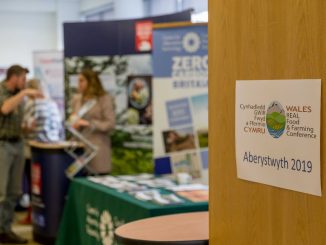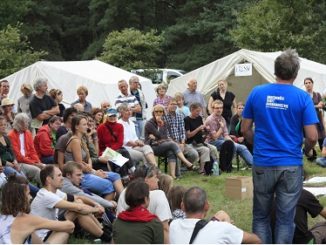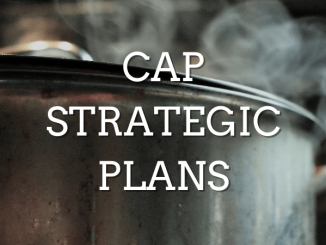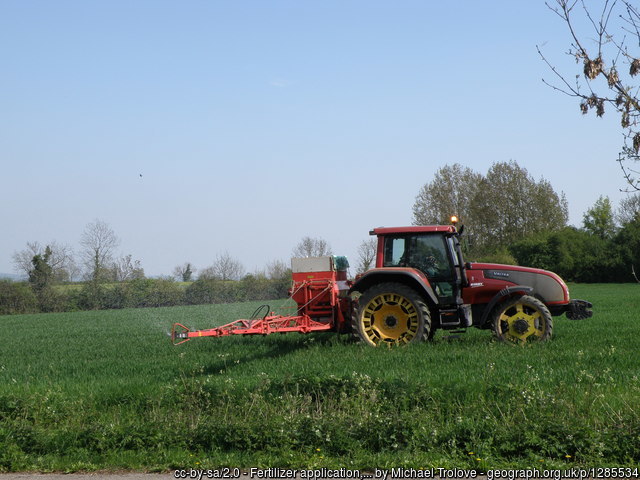
After more than 15 years living and working in Eastern Europe, the former USSR and the Middle East. Stuart Meikle returned westwards. A sabbatical followed to re-orientate himself back to North West European agriculture, food and policy issues. After the Brexit referendum, the possibilities of a UK-only policy was too interesting to pass on. A period of convalescence then allowed him the time to bring his ideas together and to write them up, thus this UK agri-food policy paper. It is an attempt to address the many relevant but complex issues at the same time. The paper was written before his soils-first policy paper published in ARC2020 (pdf) and it is best considered within the context of evolutionary thinking that is seeking to find definitive policy solutions.
Here we present the second of 12 policy objectives for the UK by Stuart Meikle.
Minimising Farming and Food’s Net Greenhouse Gas Emissions (Key Objective Two)
Greenhouse Gas (GHG) emissions from food production is a far more complex issue than is often portrayed. To date, it has too often been presented in terms of emissions and not net emissions; thus, ignoring the natural carbon cycles. GHG emissions must be measured, considered and presented in terms of sequestration and emissions; not least because returning carbon to soils is vital for soil fertility and food security. It should be added that farming should be judged upon its net emissions when producing food and it should not be considered as a carbon sink to offset emissions from other sectors.
Reducing food waste will lower the farming and food emissions from producing the wasted food. As comprehensive as this series is, reducing the vast food waste at the household, retail and food distribution levels is beyond the remit that the author has chosen to impose upon the policy paper.
The following policy statements address GHG emissions from both the emissions-reduction and sequestration perspectives. In total, they address the important issues of soil fertility, rebuilding soil organic matter levels and returning carbon into the soil [the World’s largest carbon storage sink]; all of which have significant positive consequences for both reducing atmospheric carbon levels and improving mankind’s long-term food security.
In terms of GHG emissions, they need to be fully investigated. This may require revisiting what has become accepted wisdom. It is about improving the GHG-related farm-management information flow to decision makers in farming and ensuring that it has no issues-motivated bias. That said, while the emissions-sequestration situation is fast moving, it is far too reliant on research that has often been undertaken outside of the mainstream. It is fair to say that the research field now required left the mainstream at around 1960 with the incoming belief that chemistry could overcome Nature and, by so doing, guarantee our food supplies. We have a major knowledge gap, and it is imperative that it is filled as soon as possible. We need to know much more about emissions AND carbon sequestration.
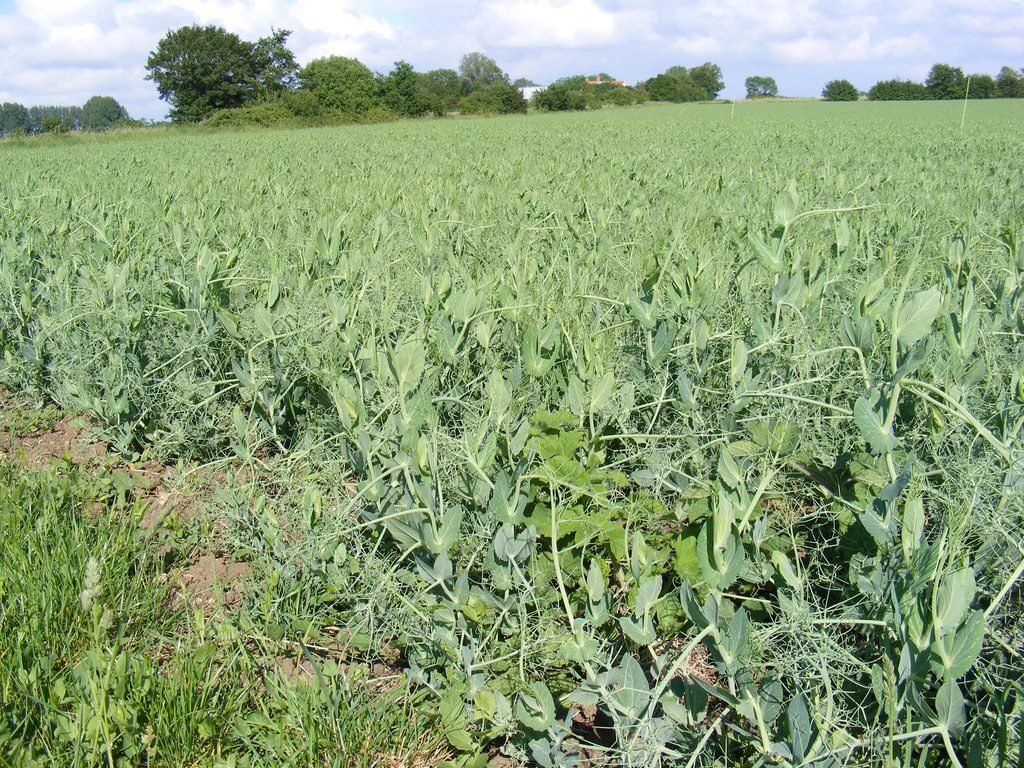
Central to this chapter is the role of soil as a carbon sink and the need to restore soil fertility. Whereas retaining and storing carbon in the soils should be an obvious climate-change mitigation [it has been called a ‘low-hanging fruit’], improving soil fertility through the natural processes of grazing, returning animal manures, and using legumes to fix atmospheric nitrogen has the indirect benefit of reducing the farmer’s reliance on artificial nitrogen fertilisers manufactured using fossil fuels. The probability that there will also be positive benefits in terms of food’s nutritional qualities, farmland biodiversity, pollinator recovery and animal welfare, suggests that policies can give multiple positive outcomes.
Beyond the soil-related issues, various other GHG-emission reduction policies are proposed. These include reducing carbon and nitrous oxide losses emanating from crop production and minimising GHG emissions from confined livestock and the storage of their manures. With the latter, there is the clear statement that there should be a balanced consideration given to reducing emissions from a) housed livestock that are reliant on imported feeds and the storage, transportation and distribution of their manures and, b) livestock that graze and consume home-grown forages with their manures returned to the farm’s soil; thus, minimising the ‘logistics’ of the food system’s various nutrient cycles.
B1. CLARIFYING THE GHG EMISSIONS PER UNIT OF NUTRITION GROWN
B1.1 Government to finance research to clarify the GHG emissions from food production
This should be the starting point of a new policy. Unfortunately, despite the urgency over climate change, too little has been done to understand the GHG-emissions implications per unit of nutrition produced. The research results should consider emissions, sequestration and mitigation and they should be available for different systems that produce what, from a basic nutritional perspective, are nutrients from the same source [i.e. meat from grass-fed or grain-fed cattle]. The research should also account for climatic and/or soil constraints on local food-production options. At present, the lack of research and the timeframe involved means food and farming policy must be made ‘on the hoof’.
B2. REDUCING THE CARBON LOSSES FROM CULTIVATED ARABLE SOILS
B2.1 Government to offer tapered-over-time payments to switch to conservation-tillage
A contributor to increasing atmospheric carbon levels has been the loss of carbon from arable land. Traditional tillage methods and leaving soil exposed to the elements have contributed to both soil carbon loss and soil loss through erosion. Conservation/minimum/zero tillage techniques are part of the solution. Their adoption will usually lead to short-term falls in productivity so it is appropriate to compensate farmers for income losses arising from taking-up climate-change-mitigating practices. Tapered payments are proposed as productivity should begin to rise as soil health improves over time.
B2.2 Government to fund a scrappage scheme for traditional tillage-farming equipment
Adopting conservation-tillage practices to minimise GHG emissions from arable soils requires farmers to use non-traditional cultivation practices. Often, farmers would have made significant investments in, for example, ploughs that are rendered obsolete by system change. As this change is promoted for climate-change mitigation; it is recommended that a scrappage scheme [as used to encourage the replacement of high-emissions road cars] is implemented to support tillage-machinery change-over.
B2.3 Government to grant-support or tax-incentivize purchase of zero-tillage equipment
As a part of a scrappage scheme [B2.2] or where scrappage is not needed, it is recommended that grants [as a percentage of the replacement equipment cost] or enhanced tax allowances are given to encourage farmers to adopt arable-farming practices that minimise GHG emissions from arable soils.
B3. SEQUESTERING CARBON BACK INTO THE ARABLE SOILS OF BRITAIN
B3.1 Government to fund research into grazing methods to increase soil organic matter
There is a debate about how much atmospheric carbon can be recycled into the soils by the actions of ruminants grazing grasslands. It is likely that grazing practices will have an impact. It is also likely that there is greater potential to sequester carbon into depleted-of-soil-organic-matter arable soils. It is possible that mob-grazing of herbal leys in arable rotations may be able to sequester significant amounts of carbon to restore soil-organic-matter levels and enhance soil-fertility and provide a long-enough break from arable crops to allow, for example, herbicide-resistant blackgrass to be controlled. Such grazing should also benefit animal and soil-biome health. Further investigation is warranted.
B3.2 Government to support the inclusion of rotational herbage leys for grazing animals
The rotational ley was vital to maintaining soil fertility in the mid-19th century, as mixed farming, with its fertility derived from folded sheep and yarded cattle, was becoming uneconomic. Ley farming’s rise was short-lived however as artificial fertilisers became the quick-fix, fertility-solution. A consequence of the latter has been the loss of soil organic matter and the soil carbon that it secured. For many reasons, a return of herbal leys into arable rotations would be beneficial. In addition to the benefits mentioned in B3.1, can be added enhancing the future of farmland flora and fauna and, especially, pollinators. Hence, there is ample justification to provide support to help farmers to sow herbal leys.
B3.3 Government to grant-fund farm-infrastructure for grazing animals on arable farms
Grazing livestock will be invaluable in restoring soil organic matter. The demise of mixed farming in favour of just cropping has left most arable farms without grazing infrastructure. The return of grazed rotational herbage leys will require infrastructure investment in external fences [although electric may suffice] and water supplies [mobile or fixed]. The support should not be limited to farmers grazing ruminants but should also be available for grazing poultry [kept in mobile housing] on arable farmland.
B3.4 Government to encourage new arable-grazing partnerships to create ‘flying herds’
As so few arable farms have grazing livestock, a solution may be to encourage farming partnerships whereby the land is farmed by the existing arable farmer [or landowner] and a livestock farmer. Farming partnerships are common place between landowners and arable farmers so a partnership would be an understood practice. A simpler system would be grazing contracts. As the grazing-arable-land system would mean sowing rotational leys on land without livestock barns, it would require hardy stock that can outwinter with the ‘flying herd’ moving to freer-draining land for the winter. Due to lower infrastructure needs, such an integrated farming system will be easier with sheep than cattle.
B3.5 Government to grant-fund farm-animal breed one-off, breed-switch-over scheme
As with tillage, changing cattle rearing will require a technological change. Cattle will need to be suited to low-cost, forage-based, out-wintered systems. For this the continental breeds may not be the right choice. If so, farmers will need to change their herds to hardier native-British types. A one-off incentive payment to offset the cost of making this necessary ‘technological’ change should be considered.
B4. PRODUCING MEAT AND MILK FROM ONLY FORAGES AND GRAZING
B4.1 Government to fully support the development of herbage-fed-only farming-systems
There are farmer-led initiatives in Britain to raise cattle and sheep on a diet 100% derived from grazed and conserved forages. It is believed that meat and milk from such systems will have a very different carbon emissions-profile to ‘grain-fed’ milk and meat. Some believe that such systems could be carbon neutral or have a net sequestration rate. If this is correct, it is imperative, from a climate-change perspective, that the Government supports the development of 100% herbage-fed systems or, at worst, systems that use only supplements grown within the home-farm’s arable-ley cropping-rotation.
B4.2 Government to re-visit the BSE-related 30-month maximum age for grass-fed cattle
Fast cattle growth rates are difficult to achieve off grass alone. Likewise finishing fast-growing cattle breeds. Although achieving fast growth rates is cited as a reason for feeding grains [and growth hormones] to reduce lifetime GHG emissions per kilo of beef, it does not account for sequestration. It also does not consider the carbon sequestration and soil-restoration [a strategic food security reason for farming cattle] potential of grazing cattle on herbage-leys sown on arable land where slower-growing traditional breeds may be the right choice. This, and the fact that the cattle will be raised on mainly forage-based diets, means that the 30-month-slaughter-age limit should now be re-visited.
B5. MIXING TREES WITHIN FARMING SYSTEMS TO SEQUESTER CARBON
B5.1 Government to provide grant aid to plant hedgerows, shelterbelts and small woods
Hedges and hedgerow trees are multi-functional as they provide shelter from winds, heavy rain and the sun while simultaneously storing carbon in their root systems, trunks and branches. Their leaf loss provides organic matter which is incorporated by soil-dwelling organisms to create soils with a high carbon content. Hedgerows must return to be integral to a more diverse, mixed-farming landscape.
B5.2 Government to give ‘wayleaves’ for hedgerows and sedentary, on-farm shade-trees
A landscape with hedgerows and hedgerow trees has greater value than that measured in monetary terms. As stated in B4.1, hedgerows and their trees sequester carbon and provide biodiversity and farming benefits. Crucially, their plant diversity supports the pollinators vital to human food security. Parkland is an iconic part of British landscapes while its sedentary trees shelter grazing animals. Hence, there are many good reasons for providing wayleaves [as per utility poles and pylons] in exchange for farmers keeping sedentary trees and maintaining the hedgerows that crisscross their farmland.
B6. CAPTURING GHG EMISSIONS FROM FARM ANIMALS KEPT INDOORS
B6.1 Government to establish a timeframe for installing bio-gas plants for animal housing
If animals are housed permanently or for lengthy periods, barns and manure storage must incorporate emissions capturing and utilising systems. Derogations will be given to short-period housing for pigs and poultry that are mainly grazed and for ruminants that must be housed in the worst winter weather and where their grazing activities are managed specifically to sequester atmospheric carbon into soils.
B6.2 Government to grant-aid biogas systems where long-term livestock housing is in use
After considering the animal welfare and GHG issues concerning animal confinement, the Government should establish a capital grant scheme to support the installation of biogas systems. Grant aid is justified as previously GHG emissions capture was not of great concern with livestock housing design.
B7. FARMING WITH TECHOLOGIES THAT MINIMIZE FOSSIL-FUEL USAGE
B7.1 Government to fund research into lowering the use of fossil-fuels in food production
GHG emissions from food production are not solely about gases emanating from ruminants and their manure or the carbon losses from tillage land or the release of GHG’s from nitrogenous fertilizer applications. It is also about the many ways that fossil fuels are used; be they for materials transport before and after the farm-gate, to power the many on-farm activities, in the creation of agricultural inputs like fertilizers and plastics [in various guises], or in the food-processing sector. In every part of the farming and food chain there are chances to reduce emissions and the Government needs to take a proactive role by funding the research needed to identify the many emission-reducing opportunities.
B7.2 Government to offer grant aid to adopt technologies that minimise fossil-fuel usage
Climate-change-friendly meat and milk production is not just about methane. It is also about reducing N2O and non-renewable fossil-fuel usage. It is about lowering energy use in crop-growing tillage and in animal feed production and when returning manure and composted food waste to the land. There are numerous farming-system solutions including, for instance, integrating productive fruit or nut trees with grazing where animals collect their own food and distribute their own manures. They are systems that need to be judged on their net emissions and not just financial profit. Often labour and management use will be higher to substitute for fossil fuels and there will be economic consequences that may, if the GHG emissions benefits are great enough, warrant off-setting by Government support.
B7.3 Government to give support to users of non-fossil-fuel-using motive-power on farms
Encouraging the growth of financially-viable market-gardens and smallholdings and the production and marketing of local, premiumised foods should reduce food-related emissions. Further, support as capital grants and annual support, should be given where farmers wish to use traditional horse power and animal traction in general. This will also preserve threatened breeds like the Suffolk heavy horse.
B8. TAKING POSITIVE ACTIONS TO LOWER ARTIFICIAL N-FERTILISER USE
B8.1 Government to develop grassland schemes that stipulate reduced N-fertiliser usage
There are environmental and input-cost benefits from reducing the artificial nitrogen use on grassland. There is also increasing evidence that by, for example, including legumes in swards to fix atmospheric nitrogen, forage production may not be compromised. The swards may also be more resilient to, for instance, drought. A year-on-year target to reduce N-fertiliser use on grassland should be established.
B8.2 Government to provide transition payments to grassland farmers reducing N-usage
It is appropriate to give transition-to-organic-farming payments. Within this paper it is also proposed to offer time-limited, transition-to-no-till, payments. Another time-limited, tapered-payment scheme should be offered to grassland farmers who undertake a phased reduction in nitrogen fertiliser use.
B8.3 Government to develop less-N grassland scheme label to fully inform the consumer
It is important to transmit to the consumer-taxpayer what farmers are doing. If they are in a specific GHG-reduction scheme, the scheme should employ a point-of-sale label to inform the consumer and a supply-chain label for use when farm produce is sold business-to-business within the supply-chain.
B9. TAKING ‘NEGATIVE’ ACTION TO LOWER ARTIFICIAL N-FERTILISER USE
B9.1 Government to evaluate the practicality of an artificial N-fertiliser tax to limit usage
The preferred option is to provide positive measures to reduce N-fertiliser usage. If investment is required and/or higher annual costs are needed to compensate for lower N usage, imposing a further tax cost may be counterproductive. Likewise, if less N lowers yields without a compensatory price rise.
B9.2 Government to evaluate the practicality of taxes on some pesticides and phosphates
Taxation should be considered if positive actions do not lower pesticide use and phosphate pollution.
B10. USING ON-FARM ENERGY GENERATION AND THE ‘OFF-GRID’ FARM
B10.1 Government to encourage the installation of energy generation on all on-farm roofs
Farming is the largest users of buildings in rural landscapes. While many have solar-energy-collection systems installed, it should be obligatory for all new buildings to be installed with, where practicable, solar-energy systems. There should be on-going support for retro-fitting all suitable buildings and this should be prioritised over the installation of new free-standing solar systems on productive farm land.
B10.2 Government to stimulate innovation to develop farms that are energy self-sufficient
Notwithstanding biogas energy linked to farm-animal wastes [an obsolete term], a target must be to move individual farms towards energy self-sufficiency. Electricity generation from solar and wind are obvious traditional energy sources, but others should include motive-power from on-farm produced bio-fuels and even using ‘hay and oats’ to provide animal-traction in woodlands and on smallholdings.
B11. GROWING PROTEIN CROPS IN BRITAIN TO CUT SOYMEAL IMPORTS
B11.1 Government to give direct annual support payments for the growing of protein crops
There are justifications for direct support to encourage British production of protein crops like beans and peas. These include import substitution of proteins derived from crops whose cultivation is known to have major negative environmental impacts elsewhere [land-use change, biodiversity loss, farming monocultures and/or soil degradation]. Within UK agriculture, leguminous crops, grown in rotations, should also improve soil fertility and health, fix atmospheric nitrogen, and improve crop-plant health and weed control. Recommendation B11.1 rarely stipulates on-going annual support for production.
B12. DEFINING EFFICIENCY TO MINIMISE THE GHG EMISSIONS PER UNIT
B12.1 Government to fund research into defining GHG-related key performance indicators
Managers need to be able to measure farm-business performance with regard to GHG-emissions from each farm activity. New key performance indicators need to be defined for the industry accordingly.
B12.2 Government to fund research to create GHG-related farm management information
Environmental considerations are an important part of this policy paper and they will redefine the objectives and operational constraints for farm businesses. They will also result in the adoption of new farming systems. Consequently, farming’s management information will need updating accordingly.
B13. ENCOURAGING LOW-EMISSIONS FOOD-SUPPLY-CHAIN SOLUTIONS
B13.1 Government to fund research into specifying GHG emissions from food supply-chains
‘Food miles’ is not an adequate indicator of the GHG emissions of food choices. Slow shipping of large volumes of ambient commodities over great distances may create less emissions than perishable food moved in small volumes over short distances. Consumers need to be informed about their choices.
B13.2 Government to target support for local production where the GHG benefits are clear
Consumer demand may exist for local foods but processing bottlenecks may forestall production. Their supply from elsewhere in Britain might be feasible but the GHG shipping emissions may be high and the full GHG cost might not be reflected in the shipping cost. Such cases should be identified and, if viable, rectified with Government funding that has been evaluated using complete-cost analysis.
B13.3 Government to inform consumers about the GHG benefit of eating seasonal produce
There is often a heavy environmental cost associated with eating out-of-season fresh produce. It may be UK grown in controlled conditions or imported. Consumers must be informed about their choices.
B13.4 Government to encourage initiatives that stimulate local recycling of food-packaging
Packaging incurs environmental costs from its manufacture, its shipping and its disposal. Plastic usage is common place in the food sector and the amount of plastic recycling is very, very low. A convincing argument for buying local is that it creates opportunities to minimise and recycle packaging and to use biodegradable packaging. The Government needs to incentivise schemes whereby packaging is re-cycled. It must ensure that regulations do not create bureaucratic and financial costs that prohibit the recycling of packaging. An obvious example is the local and very traditional reusing of milk bottles.
B13.5 Government to encourage retailers to be less reliant on plastics for food-packaging
Supermarket retailing with its highly centralised purchasing and distribution systems, has become very plastic dependent. The Government needs to sponsor investigations into how this dependency can be reduced and then removed. The aim should be to identify merchandising, food-chain and sourcing solutions that are not plastics reliant. This should include more local sourcing from small producers. The findings must be transmitted to consumers so they can make better-informed purchasing choices.
The Series so Far
Book Serialisation | Creating a New British Farming Food and Rural Policy



